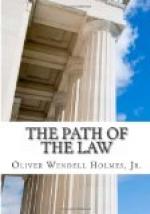Let me take an illustration, which can be stated in a few words, to show how the social end which is aimed at by a rule of law is obscured and only partially attained in consequence of the fact that the rule owes its form to a gradual historical development, instead of being reshaped as a whole, with conscious articulate reference to the end in view. We think it desirable to prevent one man’s property being misappropriated by another, and so we make larceny a crime. The evil is the same whether the misappropriation is made by a man into whose hands the owner has put the property, or by one who wrongfully takes it away. But primitive law in its weakness did not get much beyond an effort to prevent violence, and very naturally made a wrongful taking, a trespass, part of its definition of the crime. In modern times the judges enlarged the definition a little by holding that, if the wrong-doer gets possession by a trick or device, the crime is committed. This really was giving up the requirement of trespass, and it would have been more logical, as well as truer to the present object of the law, to abandon the requirement altogether. That, however, would have seemed too bold, and was left to statute. Statutes were passed making embezzlement a crime. But the force of tradition caused the crime of embezzlement to be regarded as so far distinct from larceny that to this day, in some jurisdictions at least, a slip corner is kept open for thieves to contend, if indicted for larceny, that they should have been indicted for embezzlement, and if indicted for embezzlement, that they should have been indicted for larceny, and to escape on that ground.




